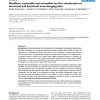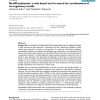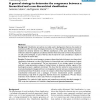BMCBI
2007
14 years 14 days ago
2007
Background: 3D-Jury, the structure prediction consensus method publicly available in the Meta Server http://meta.bioinfo.pl/, was evaluated using models gathered in the 7th round ...
BMCBI
2007
14 years 14 days ago
2007
Background: Software tools that model and simulate the dynamics of biological processes and systems are becoming increasingly important. Some of these tools offer sophisticated gr...
BMCBI
2007
14 years 14 days ago
2007
Background: The number of algorithms available to predict ligand-protein interactions is large and ever-increasing. The number of test cases used to validate these methods is usua...
BMCBI
2007
14 years 14 days ago
2007
Background: Three-dimensional (3-D) visualization of multimodality neuroimaging data provides a powerful technique for viewing the relationship between structure and function. A n...
BMCBI
2007
14 years 14 days ago
2007
Background: The Stanford Tissue Microarray Database (TMAD) is a repository of data serving a consortium of pathologists and biomedical researchers. The tissue samples in TMAD are ...
BMCBI
2007
14 years 14 days ago
2007
Background: Classification studies using gene expression datasets are usually based on small numbers of samples and tens of thousands of genes. The selection of those genes that a...
BMCBI
2007
14 years 14 days ago
2007
Background: Investigators in the biological sciences continue to exploit laboratory automation methods and have dramatically increased the rates at which they can generate data. I...
BMCBI
2007
14 years 14 days ago
2007
Background: The sequencing of many genomes and tiling arrays consisting of millions of DNA segments spanning entire genomes have made high-resolution copy number analysis possible...
BMCBI
2007
14 years 14 days ago
2007
Background: A combination of multiple types of transcription factors and cis-regulatory elements is often required for gene expression in eukaryotes, and the combinatorial regulat...





